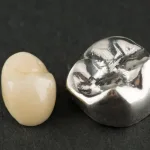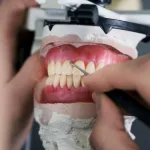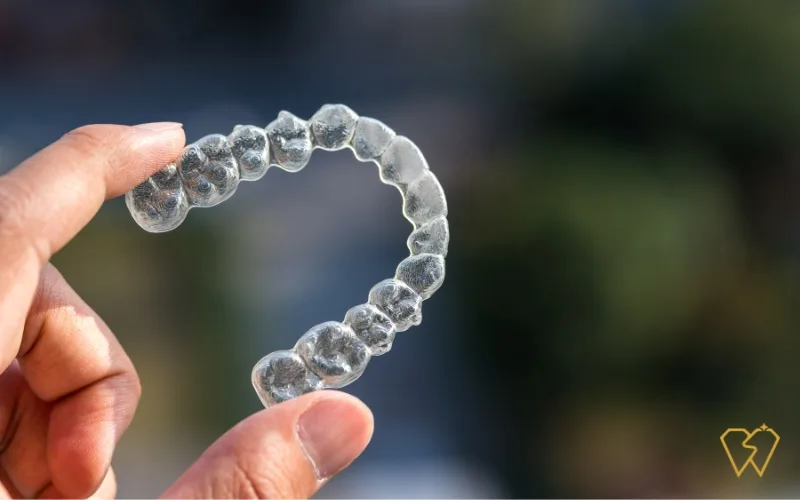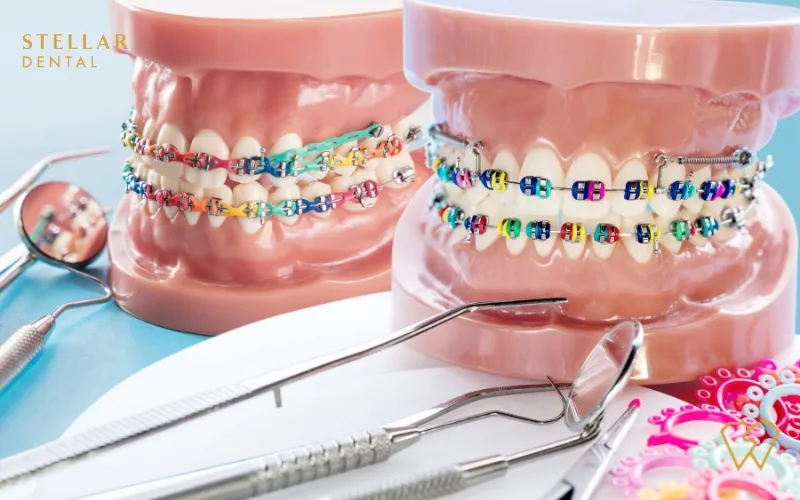A dental crown or a tooth crown is a tooth-shaped cover cemented over a damaged tooth or artificial tooth root (called an implant). Crowns hide damaged or discolored teeth and are generally a long-term solution for restoring the tooth to its standard shape or size. They also act as a hardened shield for a tooth weakened due to a filling or another dental procedure. The dental crown is cemented onto your tooth and covers the visible portion of it and as a result, it can enhance the appearance and function of an existing tooth.

Why do you need a dental crown?
You may need a dental crown for various reasons, including:
- Protecting a decayed tooth from breaking or holding a weak tooth together if parts of it are cracked
- Repairing a broken tooth
- Covering a large dental filling
- Supporting a dental bridge
- Surrounding crooked or discolored teeth
- Providing cover to a dental implant
- After root canal treatment
Types of dental crowns
Crowns are classified depending on their building material. Dental crowns can be made of stainless steel, porcelain-fused-to-metal, all metal, resin-fused-to-metal, or ceramic-fused-to-metal.

Stainless steel crowns
Stainless steel crowns are prefabricated crowns used to cover permanent teeth for some time. While a temporary crown protects the tooth or filling, a permanent crown is made of a different material. A stainless-steel crown is commonly used on children to fit over a primary tooth. The crown protects the entire tooth from further decay by covering it completely. The crown naturally comes out with the primary tooth.
Pros:
- Strong enough to protect damaged primary teeth
- Easy to maintain
- Rarely chipped or broken
- Less expensive than custom-made crowns
- Do not need multiple dental visits
Cons:
- Need tooth preparation
- Can cause gingival inflammation
- Unsuitable metallic color
All ceramic/ porcelain crowns
All-ceramic or all-porcelain dental crowns match natural colors better than any other crown type. They may be more suitable for people allergic to metals. These crowns can benefit front and back teeth.
Pros:
- Suitable for people allergic to metals.
- Can be matched to the natural tooth color.
- More durable and don’t chip as easily.
Cons:
- Less durable than porcelain-fused-to-metal crowns.
- They may weaken the adjacent permanent tooth more than metal or resin crowns.
Gold crowns/ Metal alloys
Among the metals that can be used in dental crowns are gold, platinum, nickel, chromium, and base-metal alloys. Metal crowns are an excellent choice for molars that are not visible.
Pros:
- Excellent choice for hidden molars.
- Require minimal tooth preparation.
- Most durable because they can withstand biting and chewing forces.
Cons:
- Most expensive dental crown type.
- Have a bright metallic appearance that contrasts with the other teeth.
- Can cause metal allergies to some people.
Zirconia crowns
Zirconia is a metal that is a relatively new material used in dental crowns. A zirconia crown is more closely related to a ceramic crown.
Zirconia crowns are well-known for their durability and strength. These crowns have the power of metal but the appearance of ceramic but cost more than traditional crowns. They range in price from $1,000 to $2,000 each in the US.
Pros:
- Have the same longevity as other metal crowns but are more aesthetically pleasing than other metals.
- Highly durable and resistant to chipping and breaking.
- High level of biocompatibility, which means it is less likely to be rejected by your body.
- Suitable for people with metal allergies.
Cons:
- Zirconia crowns match natural tooth color better than metal ones but are more difficult to match than ceramic ones.
- If not adequately prepared, they can fail.
- Not all dentists are trained to prepare the tooth for a zirconia crown.
Porcelain fused to metal crowns (PFM)
PFM crowns, or porcelain fused to metal crowns, are made with a metal-alloy interior and a porcelain exterior. This combines the strength of metal crowns with the aesthetics of porcelain crowns. These crowns can be color matched to your neighboring teeth (unlike the metallic crowns). However, compared to metal or resin crowns, this crown type causes more wear on the opposing teeth. PFM crowns are suitable for front or back teeth and long bridges where metal is required for strength.
Pros:
- Great visual appeal because they have porcelain on the outside which can match the surrounding natural teeth.
- Extremely durable that can withstand the stress of chewing and years of wear and tear. As a result, PFM crowns can last for many years.
- Less expensive compared to an all-porcelain crown while still providing the aesthetic benefits.
Cons:
- Despite their porcelain exterior, PFM crowns contain metal. This metal is visible at the base. Usually, the gums cover it, but if they recede, a dark line may appear.
- May cause an allergic reaction in people with metal allergies.
- Requires a more natural tooth structure to be removed to accommodate this type of crown.
Composite resin crowns
A crown for tooth made entirely of resin are less expensive than other crowns. However, they deteriorate over time and are more prone to fracture than porcelain-fused-to-metal crowns.
Pros:
- Economical as compared to other types of dental crowns.
- Aesthetically pleasing because these crowns closely resemble teeth’ natural appearance and color.
- Because resin crowns are metal-free, people with metal allergies can use them without fear.
Cons:
- Less durable, last only a few years, and need a replacement.
- A significant amount of enamel is removed to fit on these crowns on teeth.
- There is a risk of gum inflammation with these crowns.
Temporary and permanent crowns differences
Temporary crowns can be created in your dentist’s clinic, but most permanent crowns are manufactured in a laboratory. Temporary crowns are generally made of acrylic or stainless steel. These crowns are a quick solution until the lab manufactures your permanent crown.
There are multiple types of crowns, and each has advantages and disadvantages. An experienced dentist will recommend the best type depending on your condition.
The procedure of getting a dental crown
To prepare for a dental crown, you must visit the dentist twice. Sometimes, a temporary dental crown can be made in your dentist’s clinic.
The first visit
During the first visit, your dentist examines and prepares the tooth that will get the crown. The dentist takes X-rays of the tooth and the bone surrounding it. Your dentist performs a root canal treatment if there is tooth decay, risk of infection, or damage to the pulp.
The crown-bearing tooth is then filed down across the top and sides. This makes room for the crown. The amount of teeth removed is determined by the type of crown you get. All-metal dental crowns are thinner and require less tooth removal than all-porcelain or porcelain-fused-to-metal crowns. If your tooth is missing too much of its structure due to damage or decay, a filling material can “build up” enough tooth structure.
After reshaping, the dentist uses a paste to take the impression of the concerned tooth and the teeth around it.
The impressions are then sent to a laboratory for processing. The crowns are made in a laboratory and usually sent to the dental clinic in two to three weeks.

The second visit
During this visit, the permanent crown is placed on your tooth. The dentist removes the temporary crown and assesses the color and fit of the permanent crown. They then use a local anesthetic to numb the tooth before the new crown is permanently cemented.
Procedure for same-day dental crowns
If your dentist has the necessary equipment, temporary crowns can be made in their clinic. The first step of the process is similar to how a traditional crown is made. The dentist removes the decay and shapes the tooth to fit perfectly inside the crown.
The second step is different. Your dentist uses a scanning device to take digital pictures of the tooth. Computer software uses these images to create a 3D model of the tooth. The design is then sent to another in-house machine, which carves the crown shape out of a ceramic block. This technique is computer-aided design/computer-aided manufacturing (CAD/CAM). The crown is ready to be cemented in less than 15 minutes.
Maintenance and care of your dental crown
Once the crown is in place, it must be appropriately cared for. Careful attention to your crown can help it last longer. Here are some pointers:
- Brush and floss your teeth with care. Use sensitivity-protective toothpaste if you feel sensitive to heat or cold.
- Avoid hard foods. Your crown may crack while eating hard foods, especially porcelain ones.
- Your dentist may recommend a night guard if you grind at night.
Care for a temporary dental crown
You should be extra gentle and careful when working with a temporary crown because the adhesive is only intended for temporary installations. Brush daily, but be extra soft. When flossing, pull out the floss from the side of the tooth rather than snapping it back up.
If your temporary crown breaks, contact your dentist right away. Your dentist can fix it or make you a new one before you get the permanent crown.
Risks of complications with a dental crown
A crown can effectively solve multiple problems of your decaying or damaged teeth. However, there are risks and complications that you may encounter after receiving a crown:
Sensitivity of the teeth
A crowned tooth is not uncommon to be sensitive to heat or cold. The fit may be off if your tooth is sensitive to pressure when you bite down. Consult your dentist and discuss your issue with them.
Crown chipping
Some crowns, particularly all-porcelain crowns, are more prone to chipping. Your dentist repairs small chips, but a replacement is necessary in case of significant chips. A porcelain-fused-to-metal crown may break away, revealing the metal structure beneath. If the metal is still intact, these chips may not need to be repaired.
Crown slipping
If there isn’t enough cement holding your crown, it may become loose or even fall out. Consult your dentist if your crown feels loose or wiggly.
A dark line next to the base of a crowned tooth
You may notice a dark line next to the base of your tooth after getting a crown. This is normal, especially if you have a porcelain-fused-to-metal crown. This dark line is simply the visible metal of the crown.
Allergic reaction
Although uncommon, some people may get allergic to the metal used in some types of crowns.
How long do dental crowns last?
The lifespan of a tooth crown can range from 5 to 15 years. Some crowns are more durable than others and may last longer. For example, a 2016 study tested three types of monolithic crowns under “big bite forces” and discovered that monolithic zirconia crowns were the least likely to crack. A monolithic crown is made of a single solid piece of material, such as zirconia.
Gold crowns and porcelain-fused-to-metal crowns, in general, last the longest.
Although all-ceramic and all-porcelain crowns appear more natural, they are typically less sturdy than metal or porcelain-fused-to-metal versions. All-resin crowns also tend to wear out faster. Crowns can last for many years if properly cared for.
Dental crown price
The price of a dental crown at Stellar Dental is as follows:
- Ceramic crown: RM2600
- Porcelain bonded to metal crown: RM1800
- Metal crown: RM1600
Your dental insurance may cover the entire or a portion of the cost of your crown. However, your insurance policy may only cover certain types of crowns. Check with your insurance company for specifics on coverage.
Dental crown alternatives
Your dentist will certainly recommend the crown best suited to your situation or the best alternative option. If your tooth is too damaged to support a regular filling, they may recommend a veneer or another treatment.
Final Words
A dental crown is a cap a dentist places on a damaged tooth. It is sometimes used after a root canal or when a filling is larger than the natural tooth structure. Crowns are sometimes recommended due to cosmetic reasons.
Identifying and addressing dental problems is critical before they cause further damage. We at Stellar Dental can help you feel better about your broken, protruding, or discolored teeth by providing dental crown treatment. Our highly skilled technicians create crowns that blend in with your natural teeth. We can restore your teeth to their original strength and shape with a healthy, natural appearance and no visible black lines at the base of the gum. Contact us at +6011-3905 8508 or book an online appointment here.








